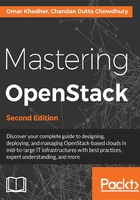
What about storage?
You should now have a deeper understanding of the storage types within Swift, Cinder, and Manila.
However, we have not covered third-party software-defined storage, Swift and Cinder.
More details will be covered in Chapter 5, OpenStack Storage , and File Share. For now, we will design from a basis where we have to decide how Cinder, Manila, and/or Swift will be a part of our logical design.
You will have to ask yourself questions such as: How much data do I need to store? Will my future use cases result in a wide range of applications that run heavy-analysis data? What are my storage requirements for incrementally backing up a virtual machine's snapshots? Do I really need control over the filesystem on the storage or is just a file share enough? Do I need a shared storage between VMs?
Many will ask the following question: If one can be satisfied by ephemeral storage, why offer block/share storage? To answer this question, you can think about ephemeral storage as the place where the end user will not be able to access the virtual disk associated with its VM when it is terminated. Ephemeral storage should mainly be used in production when the VM state is non-critical, where users or application don't store data on the VM. If you need your data to be persistent, you must plan for a storage service such as Cinder or Manila.
Remember that the current design applies for medium to large infrastructures. Ephemeral storage can also be a choice for certain users; for example, when they consider building a test environment. Considering the same case for Swift, we claimed previously that object storage might be used to store machine images, but when do we use such a solution? Simply put, when you have a sufficient volume of critical data in your cloud environment and start to feel the need for replication and redundancy.